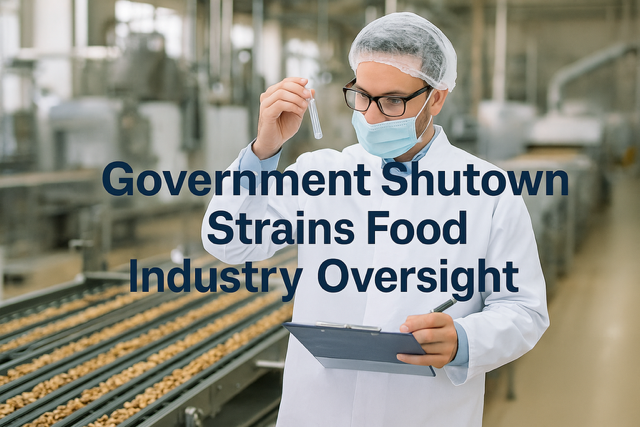Executive Summary
The recent government shutdown that began on October 1, 2025, has created significant challenges for food industry oversight, with thousands of FDA employees furloughed and routine food facility inspections halted. This analysis outlines essential hospitality cleaning best practices that can help food service establishments maintain compliance and operational continuity during periods of reduced governmental oversight.
Impact of the 2025 Government Shutdown on Food Industry Oversight
Current Regulatory Landscape
- FDA has suspended routine food facility inspections, focusing only on “for-cause” inspections related to outbreaks, recalls, or complaints
- CDC has suspended analysis of foodborne illness surveillance data, potentially slowing outbreak detection
- USDA continues meat and poultry inspections as essential services, but with reduced staffing and potential morale issues
- Multiple agencies including the Risk Management Agency, Foreign Agricultural Service, and Economic Research Service have suspended normal operations
- Critical food safety functions remain active but with reduced capacity
Hospitality Cleaning 101: Best Practices for Regulatory Continuity
1. Develop Comprehensive Internal Inspection Protocols
Implementation Strategy:
- Create standardized inspection checklists mirroring FDA/USDA requirements
- Establish daily, weekly, and monthly self-inspection schedules
- Designate qualified staff members as internal compliance officers
- Document all inspections with date/time stamps and photographic evidence
Benefits During Shutdowns:
- Maintains compliance standards despite reduced external oversight
- Creates audit-ready documentation for when inspections resume
- Helps identify potential issues before they become serious compliance violations
2. Enhance Standard Cleaning Procedures
Implementation Strategy:
- Develop science-based cleaning protocols for all food contact surfaces
- Implement color-coding systems to prevent cross-contamination
- Establish appropriate chemical concentration testing procedures
- Create detailed cleaning validation methods beyond visual inspection
Benefits During Shutdowns:
- Ensures microbial safety without relying on government verification
- Provides scientific evidence of cleanliness standards
- Reduces risk of foodborne illness outbreaks during reduced surveillance
3. Strengthen Staff Training and Certification
Implementation Strategy:
Require advanced food safety certification for all managers
- Implement continuous training programs beyond minimum requirements
- Conduct regular knowledge assessments with documented results
- Cross-train staff on compliance documentation procedures
Benefits During Shutdowns:
- Creates a workforce capable of self-regulation
- Reduces dependence on government guidance for compliance
- Ensures continuity of knowledge during regulatory disruptions
4. Implement Technology-Enhanced Monitoring Systems
Implementation Strategy:
- Deploy IoT sensors for temperature monitoring in storage areas
- Implement digital documentation systems for HACCP compliance
- Utilize automated cleaning verification systems
- Establish electronic traceability for all ingredients
Benefits During Shutdowns:
- Provides objective compliance data independent of inspections
- Creates continuous monitoring beyond periodic government oversight
- Enables rapid response to potential safety issues
5. Establish Robust Supplier Verification Programs
Implementation Strategy:
- Develop comprehensive supplier approval protocols
- Implement risk-based supplier auditing schedules
- Create contingency plans for supplier disruptions
- Require enhanced documentation from all vendors
Benefits During Shutdowns:
- Maintains supply chain integrity despite reduced oversight
- Prevents the introduction of non-compliant ingredients
- Distributes compliance responsibility throughout the supply chain
Integrating Regulatory Intelligence Tools
Key Components of Effective Regulatory Intelligence Systems
Automated Monitoring:
- Subscribe to multiple regulatory news sources
- Implement AI-powered scanning of regulatory updates
- Create customized alerts for relevant compliance changes
Real-Time Alerts:
- Establish notification systems for all key personnel
- Create escalation protocols based on alert severity
- Implement verification procedures for alert receipt
Plain-Language Summaries:
- Translate complex regulatory changes into actionable guidance
- Create role-specific compliance instructions
- Develop visual compliance aids for staff
Audit-Ready Documentation:
- Maintain centralized digital repositories of compliance records
- Implement electronic signature and verification systems
- Create automated backup and retention systems
Operational Continuity Planning:
- Develop specific shutdown response protocols
- Create decision trees for various regulatory scenarios
- Establish communication templates for stakeholders
Building Self-Sufficiency in Compliance Operations
Strategic Approaches
Risk Assessment Integration:
- Conduct comprehensive risk assessments beyond regulatory requirements
- Implement preventive controls exceeding minimum standards
- Document risk mitigation strategies with measurable outcomes
Industry Collaboration:
- Participate in industry associations for collective intelligence
- Establish information-sharing networks with similar establishments
- Create mutual support agreements for compliance resources
Continuous Improvement Cycles:
- Implement regular mock inspections and audits
- Analyze trends from internal compliance data
- Establish corrective action tracking systems
Conclusion
The 2025 government shutdown highlights the risks of overreliance on governmental oversight in the food industry. By implementing these hospitality cleaning best practices and building self-sufficient compliance operations, food service establishments can maintain high safety standards and operational continuity despite regulatory disruptions. The most resilient operations will be those that view government oversight as a supplementary verification of their own robust internal systems rather than the primary driver of compliance.
For more information, please feel free to reach out for my assistance

